Abstract
To enhance riding comfort for drivers of heavy-duty vehicles, this paper introduces a novel adaptive prescribed performance control (APPC) for active seat suspension systems. The model incorporates dynamic friction and hysteresis damping effects to capture the complex behavior of the seat suspension. The accuracy of the proposed model is validated through experimental data. The controller utilizes a prescribed performance function (PPF) to regulate the dynamic response of the system, combined with an adaptive backstepping control (ABC) method to account for system uncertainties, such as variations in driver weight, friction, suspension stiffness, and damping coefficients. A set of parameter estimators, governed by innovative adaptive laws, compensates for estimation errors. Furthermore, the stability of the controlled system is rigorously demonstrated. Both simulation and experimental tests, including bump and random excitation tests, are conducted to assess the controller performance in both time and frequency domains. The results confirm that the proposed controller effectively mitigates vibrations in the driver–seat system and demonstrates robustness against system uncertainties.
1. Introduction
Heavy-duty vehicle drivers often experience significant vibration due to road roughness, surface irregularities, and machine operations [1]. As a crucial interface between the cabin floor and the driver, an ideal seat suspension system should effectively isolate the driver from these excitations while maintaining optimal ride comfort. However, most vehicles rely on passive seat suspensions, which dissipate vibrations through a damper and inherent friction. While passive seat suspensions are widely used due to their cost-effectiveness, they present challenges in optimizing suspension parameters, and their performance can deteriorate significantly around resonance frequencies [2].
In recent years, increasing attention has been drawn to the semi-active and active suspension systems (ASSs) to improve the ride comfort. With the help of actuators, variable dampers, or variable stiffness structures, ASSs, and semi-ASSs are able to generate additional force, and thus they can filter out the unfavorable excitation from road roughness. Most of the semi-ASS structures have been proposed based on electrorheological and magnetorheological materials [3,4]. Compared to full active suspensions, semi-active suspensions have the advantage of low energy consumption and higher fault-tolerance. However, it is widely believed that active seat suspension is more efficient in isolating the vibration [5]. It is worth noting that many studies on vehicle suspension can be used as valuable references for seat suspension design due to their similar topologies. From the perspective of control method, one can observe that most of the advanced control scheme for active suspension are designed using H-infinity control [6,7,8,9], backstepping control [10,11,12,13,14,15,16,17,18,19,20], sliding mode control (SMC) [21,22,23,24], fuzzy control [25,26,27], Linear–Quadratic–Gaussian (LQG) control [28,29,30], and hybrid control methods [31,32,33,34,35,36,37,38,39].
In the review of these literatures, one can find that a major difficulty in controlling the suspension is the uncertainties of system parameters, such as the variation of sprung mass (passenger weight) and suspension characteristics. The stiffness and damping coefficients of a conventional suspension may vary with the application environment, such as the temperature, fatigue, and aging process [12]. In order to deal with the uncertain parameters, the adaptive control method is widely employed. By incorporating the backstepping control or SMC, adaptive control has proved its effectiveness in handling parameter uncertainties [11,12,13,14,15,16,17,18,19,20]. In [31,32,34], neural networks (NNs) are adopted to estimate unknown nonlinear dynamics and uncertain parameters in active suspension systems. These studies commonly employ adaptive control frameworks in which NNs approximate the system’s uncertainties, such as sprung mass variation, nonlinear spring–damper forces, or unmodeled disturbances. By integrating NN-based estimation with advanced control schemes—such as barrier Lyapunov functions, prescribed performance functions, or robust observers—they ensure boundedness or the convergence of tracking errors while satisfying system constraints. The Takagi–Sugeno (T–S) fuzzy method provides an alternative way to handle these uncertainties without designing adaptive laws. In [37,38], dynamic sliding-mode controllers based on T–S fuzzy models are developed to handle nonlinearities and uncertainties in active suspension systems. The results show improved ride comfort and robustness, while ensuring suspension deflection and road-holding constraints under varying vehicle conditions. In [38,40], an approximation-free control method is presented, which can deal with uncertainties without using an estimator. The performance of the active suspension relies heavily on the dynamic behavior of the actuator. In many of the existing studies, such as [10,11,40], the actuator is modelled as a simple linear function of the control signal. However, it is known to us that nonlinear properties are frequently encountered in a practical actuator, such as the hydraulic actuator and electromagnetic actuator. In addition, the actuating force can be affected by the real-time status of the suspension as well. Plenty of studies have been carried out to compensate the impact of non-ideal actuators. In [6,10,33], H-infinity control methods are used to handle time-varying gains, actuator faults, and saturation in active suspension systems. These approaches improve system stability and ride comfort under uncertainties and constraints. In [12], a unified model is proposed for actuators with dead-zone and hysteresis characteristics. The method addresses both nonlinearities without requiring prior knowledge of actuator parameters or output measurements. Compared with inverse-based approaches, it is simpler to implement and more robust to uncertainties, though it may require careful gain tuning. In [15,32], actuator saturation is managed using auxiliary systems [15] via anti-windup compensation in adaptive robust control, and [32] with a neural network-based controller. These methods improve robustness but increase system complexity. In [21], an adaptive method is integrated with the SMC to compensate for the influence of unknown control gain, which improves system robustness but may increase computational complexity. It is also noted in [40,41] that the prescribed performance function (PPF) has been widely adopted because it provides a shortcut to regulate both the transient and steady-state performance of the controlled system, and the system output and tracking error can be controlled to an arbitrarily small residual set.
In this paper, an adaptive controller based on backstepping control and PPF is designed to improve ride comfort for heavy-duty vehicles. The main contributions of this study are as follows: (1) An APPC is designed to regulate the transient and steady-state performance of the active seat suspension system. (2) A new adaptive law is introduced for parameter uncertainty estimation and friction compensation. (3) A prototype of an active seat suspension is presented and both numerical simulations and experimental validation are conducted to demonstrate the effectiveness of the proposed controller.
The remainder of this paper is organized as follows: Section 2 presents the dynamic model of the controlled driver–seat system and formulates the control problem. Section 3 introduces the necessary preliminaries and synthesizes the control algorithm. In Section 4, the proposed controller effectiveness is verified through numerical simulations and experimental validation. Finally, Section 5 offers conclusions and suggestions for future work.
2. System Modelling and Problem Formulation
In this section, the structure of active seat suspension and its dynamic characteristics will be introduced. Then, the model of the controlled driver–seat system will be established. The control problem will be formulated last.
2.1. Active Seat Suspension
An active seat suspension prototype is built based on a modification of a normal passive seat suspension for heavy duty vehicles, as shown in Figure 1a. The seat is supported by a pair of scissor mechanisms. An actuator is installed on the center of the left side scissor structure, which comprises a servo motor and a reduction gear.
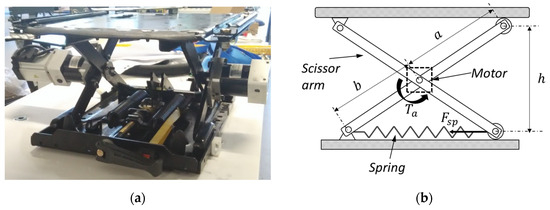
Figure 1.
Active seat suspension: (a) seat suspension and (b) schematic.
Figure 1b exhibits the schematic of the active seat suspension from which we can see that the vertical active force is realized through the motor torque , which is given as
where is the length of the scissor arm. is the suspension height, respectively. is the ratio of the reduction gear.
Because the control scheme of the servo motor is beyond the research of this study, we assume that the control gain from control signals to the active torque is roughly linear:
where is the control input signal, is the linearized control gain, and is the error of linearization.
Combining Equations (1) and (2), the relationship between the equivalent vertical actuating force and control signal can be given as
where is the equivalent control gain from the control signal to vertical active force, which will change with the variation of the suspension deformation. is an equivalent disturbance term.
In order to achieve better control performance, the original damper is removed, and the vertical stiffness is provided by a horizontally installed spring and the scissor mechanism. According to the geometry shown in Figure 1b, the vertical elastic force is calculated as
where is the elastic force of the spring with the spring rate, and is the suspension height in the equilibrium position.
Taking the partial differential of the above equation, we can obtain the equivalent vertical stiffness as
where and are the current and equilibrium length of the spring, respectively.
It can be seen from Equation (4) that the equivalent vertical stiffness will change with the variation of the suspension height. For small vibration conditions, the stiffness can be linearized at the equilibrium position.
Like the other mechatronic systems, the friction is inevitably encountered in the seat suspension. Considering that the friction force mainly results from the dry friction between the metal components, the Coulomb model is employed to depict the generalized dry friction within the system:
where is the Coulomb friction force, is the signum function, and is the deformation rate of seat suspension.
Additionally, due to the installation of the reduction gear, external damping is generated. Unlike the dry friction force, the damping force shows obvious hysteresis characteristic, which can be described using the extended Bouc–Wen differential model [42], given as follows:
where and are the non-hysteresis and hysteresis coefficients, respectively. is an auxiliary variable with , , and are the non-dimensional parameters that determine the shape and amplitude of the hysteresis loop.
Please refer to the Appendix A for the experimental verification and parameter identification of the proposed friction and damping models.
Remark 1. To facilitate the development of the controller, we rewrite the Bouc–Wen model into a simplified form. Considering the following Lyapunov function,
Taking its time-derivative yields
One can find that, for any
, we have
, which means that
is bounded. Thus, the damping force in Equation (8) can be expressed as
where
is the non-hysteresis coefficient and
is the hysteresis-resulted bounded disturbance term.
Remark 2. It is worth noting that, although the Coulomb friction, the equivalent vertical stiffness, and damping coefficients can be calculated using experimental data, they can vary greatly with the suspension deformation, working environment, fatigue, or the aging process. Thus, their accurate information can hardly be obtained in practical conditions. These parameters will be considered as uncertainties in the development of the control algorithm.
2.2. System Modelling
Without loss of accuracy, the dynamic behavior of the controlled driver–seat system can be depicted using a two-DOF (Degrees of Freedom) model, as shown in Figure 2.
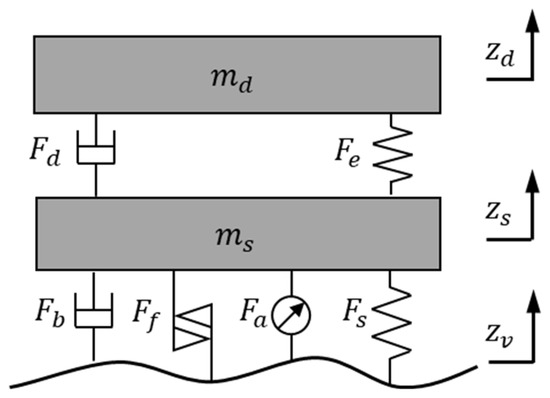
Figure 2.
2-DOF driver–seat model.
By applying Newton’s second law, the governing equations of this 2-DOF model can be obtained as follows:
where and are the masses of driver and seat, respectively. and are the elastic and damping forces between driver and seat, respectively. In fact, the seat mass is comparatively small, and the relative motion between driver and seat is usually small and negligible. By treating the seat and driver as a whole, and introducing a lumped term , the controlled system can be further modelled as
where is the integrated mass and is the lumped disturbance term.
2.3. Problem Formulation
The state variables of the driver–seat system are defined as
Combining Equations (13) and (14), the state space equations of the selected state variables are obtained as
It is noted that system (15) is highly nonlinear. On one hand, the key dynamic parameters of the system are difficult to measure accurately. For instance, the total mass varies across different drivers, the stiffness changes with the position of the seat suspension, while the nominal value of spring stiffness also becomes uncertain due to system creep. On the other hand, internal friction disturbances and the non-ideal characteristics of the controller () further complicate precise system control.
In order to overcome the above-mentioned issues, Equation (15) is rearranged through the introduction of new auxiliary uncertain parameters. As introduced in Remark 2, the controlled system has up to six uncertain parameters: the integrated mass, control gain, lumped disturbance term, Coulomb friction, equivalent stiffness, and damping coefficients. Notably, for the latter five parameters, their relative values with respect to the integrated mass are of greater interest than their absolute values. To simplify the controller development, these uncertain quantities are redefined as an uncertain vector along with two relative uncertain parameters, as follows:
where each element of represents a normalized uncertain parameter (stiffness, damping, and friction coefficient) linearly dependent on the system dynamics. In contrast, the terms and lump non-structured uncertainties including unmodeled disturbances and actuator errors.
By substituting Equation (16) into the state space Equation (15), the controlled system equation can be rewritten as
where is the control signal and is the vector of suspension deformation, which can be measured directly, given as
Here, the term explicitly captures the structured uncertainty with known regressor (measurable states) but unknown constant parameters . This structure enables adaptive compensation via parameter estimation.
Therefore, the objective of this study is to develop a proper controller such that the CL system (17) is asymptotically stable and the state variable is retained within a reasonable range in the presence of system uncertainties.
In addition, for safety consideration, the physical limit of the suspension structure and the actuator saturation should be taken into consideration as well.
(i) The suspension deformation should be retained within the limit of the suspension mechanical structure, which is given by
where is the suspension deformation, is the corresponding structural limit.
(ii) The active control torque should not exceed the limit of the motor:
where is the maximum actuating torque.
3. Control Algorithm Synthesis
In this section, an adaptive controller is developed to enhance the ride comfort of the seat suspension. To address the uncertainties in the controlled system, three estimators are designed, and a corresponding adaptive law is proposed for updating these estimators. The block diagram of the controller is shown in Figure 3.
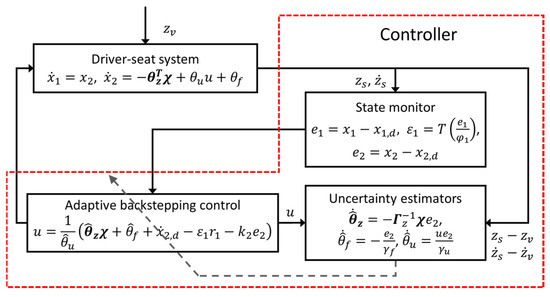
Figure 3.
Overall control structure.
3.1. Preliminary
Prescribe performance means that the tracking error strictly evolves within an appropriately designed compact set. Meanwhile, the convergence rate should be no less than a given value and the maximum overshoot is smaller than a chosen bound. The control objective can be expressed using the following inequity:
where is the PPF, and are the positive design parameters for upper and lower bounds, respectively. In this paper, is selected as the following positive and exponentially decreasing function:
where and are design parameters that prescribe the initial and final boundaries for the tracking error, respectively. is the selected convergence rate.
However, it is difficult to design a controller using the inequity (21). The following monotonically increasing function is introduced to project the control domain from to the entire real domain. is defined as
where denotes the normalized tracking error with respect to the corresponding PPF .
Lemma 1.
If a control scheme is able to guarantee the boundedness of the transformed error (23) (i.e., for
, there exists a positive constant
, such that
), then the tracking error of the corresponding state variable can be retained within its prescribed bound (21).
Proof of Lemma 1.
Taking the inverse function of Equation (23), we can obtain
Because is monotonously increasing, it is easy to prove that is monotonously increasing as well. With the condition , the following inequity can be obtained:
Because is positive, this inequity is equivalent to Equation (21). Thus, the constraint control problem is transformed into an equivalent “unconstrained” control problem.
3.2. Adaptive Prescribed Performance Control
The development of the controller will proceed in three steps. First, a PPF is introduced to prescribe the dynamic bound for vertical displacement. Second, the desired control effort is calculated using the backstepping control method. Finally, the actual control input is computed based on the estimated values, and an adaptive law is introduced to compensate for the effects of estimation errors.
Step 1. In order to guarantee both the transient and steady-state performance of a vehicle in bounce and roll motion, a PPF in the form of Equation (22) is employed to regulate the dynamic behavior of the sprung mass:
Note that the upper and lower bound parameters are selected to be identical i.e., . Based on this PPF, the transformed errors of is obtained as
where and is the reference value. Taking the time derivative of the transformed error, one can obtain
where is a positive coefficient calculated using and . According to Lemma 1, the prescribed performance (26) can be guaranteed if Equation (27) is controlled to be bounded.
Step 2. Considering the transformed error of , we select a Lyapunov function as
Taking the time derivative of the above equation gives
By letting , the desired value for can be designed as
with a design parameter. Select the second Lyapunov function as
Taking its time differential gives
Therefore, the desired control effort for bounce motion can be obtained as
where is a design parameter.
Step 3. Due to the existence of the system uncertainties, the ideal control effort (34) can hardly be computed, and thus the practical control signals are obtained by replacing the actual value with the estimated values, given as
where denotes the estimated value of .
Furthermore, in order to compensate for the influence of estimation errors on the CL stability, we select the third Lyapunov function as
Taking its time differential gives
To ensure with , the following adaptive law for updating the estimators is employed:
where , , , and are positive design parameters, is a positive definite matrix.
The structured uncertainties are characterized by a linear separation of unknown parameters from known basis functions. This property is leveraged to design adaptive controllers with stability guarantees. The adaptive law (38) exploits the linear parametric structure of in Equation (17). By estimating . via gradient-based update driven by regressor and error , the controller compensates structured uncertainties directly.
By comparing the steps of the control strategy with the content in Figure 3, it can be seen that Step 1 corresponds to the “State monitor”; Step 2 is responsible for computing the ideal control strategy, i.e., Equation (34), corresponding to the “Adaptive backstepping control”; and Step 3 corresponds to the dashed arrow, which compensates for the system’s parametric uncertainties through parameter adaptation.
Hence, the development of the adaptive prescribed performance controller can be summarized as the following theorem:
Theorem 1.
For the controlled system in Equation (17), the proposed controller (35) with the adaptive law (38) can guarantee that all state variables
are bounded. Furthermore,
is retained within the prescribed bound as defined in Equation (26).
Proof of Theorem 1.
Considering the following Lyapunov function:
The time derivative of this function is given as
By substituting Equation (31) into the above equation, one can obtain
Finally, by employing the adaptive law (38), we get the following equation:
where is a bounded term, which means the tracking errors and , and the estimation errors are bounded. According to Lemma 1, the vertical motion is retained within the prescribed bound. Furthermore, if the system is persistently excited (PE) in terms of and , then the estimation errors will converge to a small neighbor of zero. This is the end of the proof.
Remark 3. Due to the change in driver’s weight, the initial state of the seat suspension, i.e., suspension deformation, could vary in a large range. Compared to the adaptive controller using Barrier Lyapunov Function [19], the proposed controller can mitigate the actuating shock in the startup phase, which is desirable for the driver’s comfort and system safety.
Remark 4. The proposed controller is robust to modeling uncertainties, ensuring that its performance remains unaffected by changes in system parameters. The convergence rate of the system is guaranteed by the PPFs. Additionally, both transient and steady-state performance can be easily adjusted by tuning the PPF parameters.
3.3. Suspension Performance
In the above analysis, we have proved that the tracking error of vertical displacement is retained within the corresponding prescribed bound and the vertical velocity is bounded in a certain range as well. In this subsection, we will conduct the stability analysis of the zero dynamics to ensure that the CL system meets the safety constraints given at the end of Section 3. Redefining the state variable vector as follows:
Assuming that all the estimated values are the same as the real values, the zero dynamics equation can be obtained in the matrix form:
with the coefficient matrixes , , and given as follows:
It can be verified that all the eigenvalues of matrix have a negative real part, which means there always exists a pair of positive matrixes and satisfying the equity . Therefore, we can select a Lyapunov function as follows:
Taking the time derivative of Equation (46) gives
Note that, because , , and are all bounded, is bounded for a positive constant , i.e., , we can further obtain
where is a positive design parameter. By appropriately choosing , the above inequity can be rewritten as
where and . The above inequity indicates that is bounded with the upper limit , which means that is bounded as follows:
Therefore, the bounds of the suspension deformation can be guaranteed as
Furthermore, the maximum actuating force can be regulated by appropriately tuning the design parameters and such that
where is the Coulomb friction. By substituting the above inequity into Equation (1), the second safety constraint can be guaranteed.
4. Control Algorithm Evaluation
In this section, the performance and robustness of the proposed controller are evaluated through both numerical simulation and experimental validation.
4.1. Numerical Simulation
Due to the presence of friction and hysteresis damping, accurately measuring the system response to low-frequency excitations in experiments is challenging. Therefore, numerical simulation is used as a complementary approach to analyze the performance of both OL and CL systems in the frequency domain. To demonstrate the effectiveness of the proposed controller in reducing vibration transmissibility, a 2-DOF driver–seat model, as shown in Figure 2, is employed. For simplicity, an ideal actuator is assumed in the numerical simulation. For comparison, the passive case is simulated by replacing the actuating mechanism with an ideal viscous damper of 600 N·s·m−1. The nominal parameter values for the driver–seat system are provided in Table 1.

Table 1.
Nominal parameter values of the 2-DOF driver–seat model.
The existence of Coulomb friction may cause the system to be magnitude- and frequency-sensitive. Therefore, two groups of sinusoidal excitations with different magnitudes (10 mm and 20 mm) are employed to investigate the acceleration transmissibility of the seat suspension. The excitations range in frequencies from 0.5 Hz to 5.0 Hz, which can cover the main component of excitation from cabin floor to seat suspension. The steady-phase acceleration transmissibility, which is defined as the ratio between the RMS values of input acceleration and output acceleration, is used as the evaluation index. In order to achieve better control effect, the PPF of the controller is set to be relatively compact: . The control gains are selected as , .
The simulation results are summarized in Figure 4, from which one can see that the active seat suspension with the proposed control algorithm can significantly reduce the transmissibility throughout the simulated frequency range. With the increase in excitation magnitude, the active suspension becomes more effective in suppressing the vibration. One can also read that the passive system reflects a resonance at about 1.5 Hz, while the active system shows monotonically decreasing curves. Furthermore, the active suspension has a better control effect for excitations at 1~3 Hz.
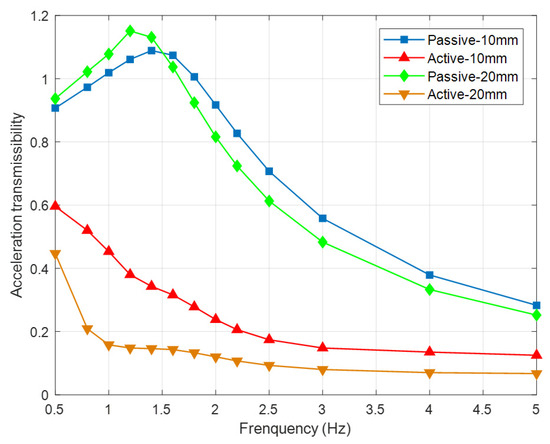
Figure 4.
Simulation acceleration transmissibility.
4.2. Experimental Validation
To further evaluate the performance of the proposed controller in a practical setting, a 6-DOF vibration platform is used to simulate the cabin floor, as shown in Figure 5. The lower base of the seat suspension is mounted on top of the platform, and two sandbags are used to emulate the driver. The active seat suspension is controlled by an NI CompactRIO 9074, equipped with NI 9205 and NI 9264 modules, operating at a control frequency of 200 Hz. Two displacement sensors (optoNCDT 1302-100, Micro Epsilon, Ortenburg, Germany) are employed to measure the vertical displacement of the seat and the suspension deformation. The vertical velocity is calculated by taking the time derivative of the displacement signal. Comparative experiments, including passive, original, and controlled cases, are conducted. The passive experiment is performed using a passive seat suspension, which consists of a spring and damper system designed for heavy-duty vehicles.
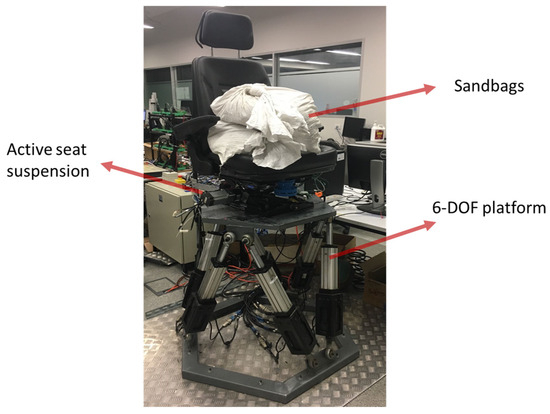
Figure 5.
Experimental setup.
Two scenarios are designed to evaluate the performance of the proposed controller. Considering the limit of the actuator, the PPF of the control algorithm in the experiments is set to be relatively loose: . The control gains are selected as , . In order to verify the robustness of the control algorithm, perturbed system parameters are applied. The total weight of the sandbags is about 60 kg, which is 15 kg less than the nominal value. Moreover, due to suspension deformation and the nonlinear spring and damper, the actual stiffness and damping coefficients of the seat suspension are time-variant and unknown. To better illustrate the performance of the proposed control strategy, the unadjusted, passive, and active cases are tested in the experiment:
- (1)
- Original case: The shock absorbers remain untuned, preserving their factory-original state (approximate 370 N·s·m−1). The motor and gear reduction are not installed.
- (2)
- Passive case: The damping coefficient has been optimally adjusted based on the nominal model (Table 1), reaching approximately 600 N·s·m−1.
- (3)
- Active case: The damping coefficient has been appropriately reduced to meet the requirements of active control, with a value of approximately 400 N·s/m.
Scenario 1. In this scenario, the driver–seat system is subject to a bump excitation. The profile of the excitation can be described using the following equation:
where m and s are the height and length of the bump, respectively. The comparison between the controlled and original systems is presented in Figure 6.

Figure 6.
System response in Scenario 1: (a) displacement and (b) acceleration.
Figure 6a shows the displacement responses for both the active and passive cases. With the passive suspension, the seat experiences a more pronounced hop, with a peak displacement as high as 0.05 m. In contrast, the controlled case exhibits a smoother curve, with vertical displacement suppressed to below 0.02 m. It is also noted that, due to the presence of friction and hysteresis damping, both cases exhibit a small steady-state error. For ride comfort assessment, Figure 6b illustrates the acceleration responses, revealing that the overall magnitude in the active case is smaller than in the passive case. The peak-to-peak acceleration value decreases from approximately 4 m/s2 to 2.9 m/s2 with the active control, representing a 27.5% improvement.
Scenario 2. To further investigate the performance of the control algorithm, a medium-low frequency random excitation signal with a maximum amplitude of 0.02 m is applied to simulate a more typical operating condition. The random excitation is generated by superimposing several sets of random signals with different characteristic frequencies, with an amplitude range of ±2 cm, and its main components are concentrated between 1 and 3 Hz, as shown in Figure 7. Its frequency-domain characteristics are similar to the vibration excitations typically borne by seat suspensions.

Figure 7.
Random excitation signal in scenario 2.
Figure 8 compares the displacement responses across different scenarios. With the passive seat suspension, the system vibrations remain within a reasonable range; however, the peak displacement exceeds 2 cm at certain frequencies, which is larger than the excitation magnitude. This indicates that the passive seat suspension amplifies vibrations at specific frequencies, an undesirable characteristic for practical applications. In contrast, the original system displays an unstable response due to its low damping coefficient, with noticeable resonance between 7 and 10 s. During this period, the peak displacement rises above 6 cm, roughly three times the magnitude of the excitation. On the other hand, the seat with active suspension exhibits the smallest vibration magnitude, with peak displacement suppressed to below 2 cm. These results highlight the effectiveness of the proposed control algorithm in isolating the seat from road roughness excitation.
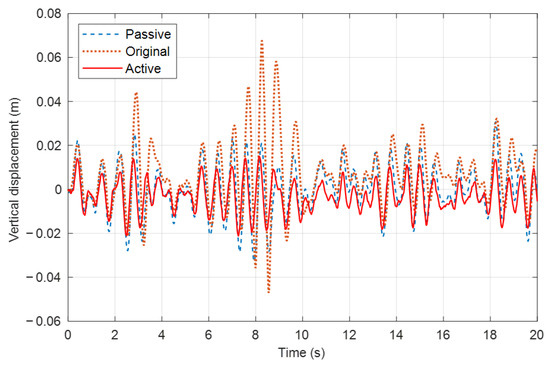
Figure 8.
Displacement response in scenario 2.
Figure 9 presents the acceleration response curves, which reflect the system riding comfort. In the original case, resonance causes the peak acceleration to reach as high as 9 m/s2. The passive seat suspension helps stabilize the system, reducing the acceleration to around 3 m/s2. However, the active seat suspension delivers the best performance, with acceleration fluctuations maintained within ±2 m/s2 throughout the entire process. Figure 10 offers a frequency-domain analysis of the three cases, showing that the active seat reduces acceleration transmissibility across a broad frequency range. The enlarged plot emphasizes that the active seat excels at mid-range frequencies (1–2 Hz), where transmissibility is reduced by more than 30%. In conclusion, the active seat significantly enhances riding comfort.
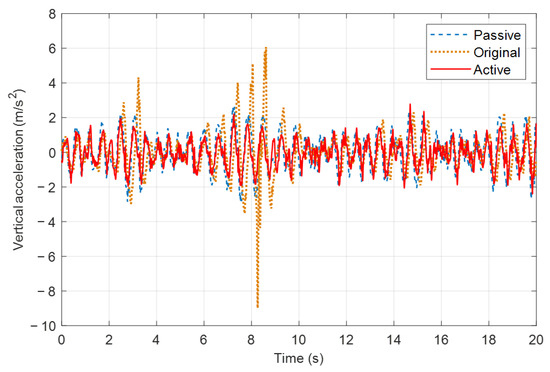
Figure 9.
Acceleration response in scenario 2.
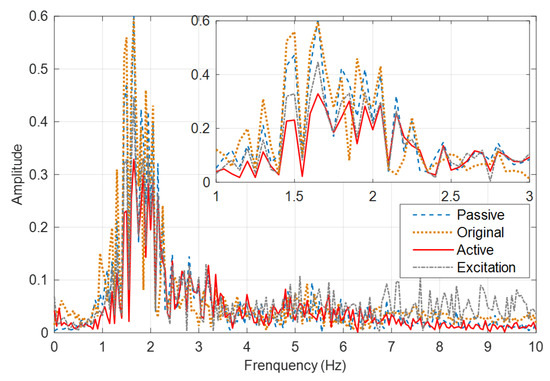
Figure 10.
PSD of the acceleration in scenario 2.
The profiles of suspension deformation and actuating force are shown in Figure 11 and Figure 12, respectively. Both the active and passive seats maintain suspension deformation within a relatively small range. However, the active seat generally exhibits slightly larger deformation compared to the passive seat, highlighting the inherent trade-off between ride comfort and suspension deformation. In contrast, the original case shows significant fluctuations due to resonance. As shown in Figure 12, the actuating force stays within ±300 N thanks to the loose settings for the PFF.
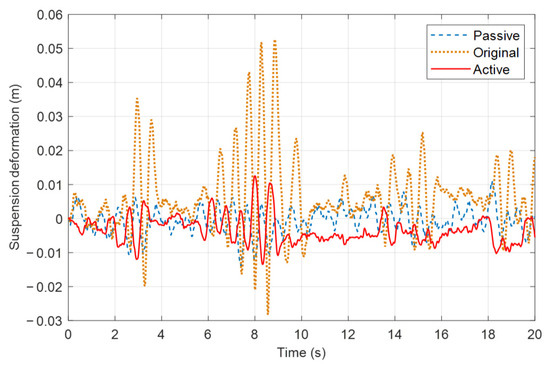
Figure 11.
Suspension deformation in scenario 2.

Figure 12.
Actuating force in scenario 2.
For quantitative analysis, the RMS values of the system responses are provided in Table 2. Compared to the original case, the active suspension achieves reductions of 34.5% in displacement and 31.3% in acceleration responses. However, the suspension deformation increases by 33.3% in the active case.

Table 2.
RMS values of the system response. The numbers marked with upward and downward arrows indicate the relative values compared to the original suspension.
5. Conclusions
In this paper, a robust adaptive backstepping control algorithm based on the PPF is proposed to enhance the riding comfort of heavy-duty vehicles. The development of the control algorithm addresses common system parameter uncertainties in detail. A PPF is employed to prescribe the dynamic behavior of the controlled system. Three estimators are introduced to derive the control signal from the unknown system parameters, and a novel adaptive law is designed to update these estimators, compensating for the effects of estimation errors. Both ride comfort requirements and safety constraints are taken into account. The CL stability is theoretically proven, and the performance of the proposed controller is evaluated through numerical simulations and experimental validation. The simulation and experimental results demonstrate that the proposed control algorithm effectively suppresses vertical vibration in the driver–seat system, even in the presence of parametric uncertainties.
The advantage of the proposed control strategy lies in its ability to maintain the control target within a preset boundary range under system uncertainty. Through parameter estimation design, the proposed control can adapt to parameter variations within a certain range, and the uncertainties of each hardware in experiments also validate this argument. It is also noted that, from the definition (23) of the transformed error, if the system is subjected to a severe disturbance in a short period, the normalized error may exceed 1, making the control signal in such cases incalculable. To improve the robustness of the control strategy, PPF can be appropriately relaxed to ensure that the normalized error is always less than 1; alternatively, a buffer boundary < 1 can be employed to replace the normalized error when exceeds , thereby ensuring that the control signal remains well-defined.
Author Contributions
Conceptualization, J.C. and Y.W.; methodology, J.C. and Y.W.; software, Y.W.; validation, J.C.; formal analysis, W.H.; investigation, Y.W. and D.X.; resources, Y.W.; data curation, Y.W. and D.X.; writing—original draft preparation, Y.W.; writing—review and editing, J.C., D.X. and W.H.; visualization, W.H.; supervision, Y.W. and W.H.; project administration, Y.W.; funding acquisition, J.C. and Y.W. All authors have read and agreed to the published version of the manuscript.
Funding
This work is supported by the Chinese National Natural Science Foundation (52202498), the Open Fund of Intelligent Crane Engineering Research Center of Hunan Province (SYC202501), and partially supported by the Youth Fund of the National Natural Science Foundation of China (52305080) and the Natural Science Foundation for Youths of Hunan Province, China (2023JJ40720).
Institutional Review Board Statement
Not applicable.
Informed Consent Statement
Not applicable.
Data Availability Statement
Data are available upon reasonable request.
Acknowledgments
We would like to express our sincere gratitude to Mi Zhou and Yibo Hu for their invaluable contributions to this research. Both Mi Zhou and Yibo Hu made significant contributions in writing, reviewing, and editing the manuscript, as well as in the visualization process. Their efforts and insights have greatly enhanced the quality and clarity of this study.
Conflicts of Interest
The authors declare that this research was conducted in the absence of any commercial or financial relationships that could be construed as a potential conflict of interest.
Appendix A
To verify the effectiveness of Equations (7) and (8), an experiment using the MTS system was conducted. The original seat suspension was subjected to sinusoidal excitations with amplitudes of 5 mm and 10 mm, at frequencies of 1 Hz and 2 Hz, respectively. By subtracting the elastic force from the measured force, the profiles of the friction and damping forces in the suspension are obtained, as shown in Figure A1.
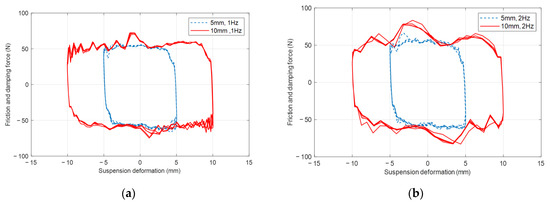
Figure A1.
Deformation-force plot: (a) 1 Hz and (b) 2 Hz.
Using the weighted-least-square method, the parameters of the Bouc–Wen model are fitted as follows: , , , , and . The Coulomb friction is identified as 36 N. Figure A2 shows the comparison between experimental and simulated data in time domain.
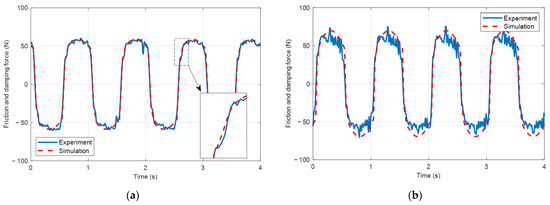
Figure A2.
Friction and damping model identification: (a) 5 mm@1 Hz and (b) 10 mm@1 Hz.
References
- Paddan, G.S.; Griffin, M.J. Effect of seating on exposures to whole-body vibration in vehicles. J. Sound Vib. 2002, 253, 215–241. [Google Scholar] [CrossRef]
- Wan, Y.; Schimmels, J.M. Improved vibration isolating seat suspension designs based on position-dependent nonlinear stiffness and damping characteristics. J. Dyn. Syst. Meas. Control Trans. ASME 2003, 125, 330–338. [Google Scholar] [CrossRef]
- Choi, S.B.; Han, Y.M. Vibration control of electrorheological seat suspension with human-body model using sliding mode control. J. Sound Vib. 2007, 303, 391–404. [Google Scholar] [CrossRef]
- Choi, S.B.; Nam, M.H.; Lee, B.K. Vibration control of a MR seat damper for commercial vehicles. J. Intell. Mater. Syst. Struct. 2001, 11, 936–944. [Google Scholar] [CrossRef]
- Sun, W.; Li, J.; Zhao, Y.; Gao, H. Vibration control for active seat suspension systems via dynamic output feedback with limited frequency characteristic. Mechatronics 2011, 21, 250–260. [Google Scholar] [CrossRef]
- Shao, X.; Naghdy, F.; Du, H.; Li, H. Output feedback H∞ control for active suspension of in-wheel motor driven electric vehicle with control faults and input delay. ISA Trans. 2019, 92, 94–108. [Google Scholar] [CrossRef]
- Van Der Sande, T.P.J.; Gysen, B.L.J.; Besselink, I.J.M.; Paulides, J.J.H.; Lomonova, E.A.; Nijmeijer, H. Robust control of an electromagnetic active suspension system: Simulations and measurements. Mechatronics 2013, 23, 204–212. [Google Scholar] [CrossRef]
- Wang, R.; Jing, H.; Karimi, H.R.; Chen, N. Robust fault-tolerant H<inf>∞</inf> control of active suspension systems with finite-frequency constraint. Mech. Syst. Signal Process. 2015, 62, 341–355. [Google Scholar] [CrossRef]
- Sun, W.; Gao, H.; Yao, B. Adaptive robust vibration control of full-car active suspensions with electrohydraulic actuators. IEEE Trans. Control Syst. Technol. 2013, 21, 2417–2422. [Google Scholar] [CrossRef]
- Basturk, H.I. A backstepping approach for an active suspension system. In Proceedings of the 2016 American Control Conference (ACC), Boston, MA, USA, 6–8 July 2016; pp. 7579–7584. [Google Scholar] [CrossRef]
- Sun, W.; Pan, H.; Zhang, Y.; Gao, H. Multi-objective control for uncertain nonlinear active suspension systems. Mechatronics 2014, 24, 318–327. [Google Scholar] [CrossRef]
- Pan, H.; Sun, W.; Jing, X.; Gao, H.; Yao, J. Adaptive tracking control for active suspension systems with non-ideal actuators. J. Sound Vib. 2017, 399, 2–20. [Google Scholar] [CrossRef]
- Pang, H.; Zhang, X.; Chen, J.; Liu, K. Design of a coordinated adaptive backstepping tracking control for nonlinear uncertain active suspension system. Appl. Math. Model. 2019, 76, 479–494. [Google Scholar] [CrossRef]
- Pan, H.; Jing, X.; Sun, W. Robust finite-time tracking control for nonlinear suspension systems via disturbance compensation. Mech. Syst. Signal Process. 2017, 88, 49–61. [Google Scholar] [CrossRef]
- Sun, W.; Zhao, Z.; Gao, H. Saturated adaptive robust control for active suspension systems. IEEE Trans. Ind. Electron. 2013, 60, 3889–3896. [Google Scholar] [CrossRef]
- Sun, W.; Gao, H.; Kaynak, O. Adaptive backstepping control for active suspension systems with hard constraints. IEEE/ASME Trans. Mechatron. 2013, 18, 1072–1079. [Google Scholar] [CrossRef]
- Sun, W.; Pan, H.; Gao, H. Filter-Based Adaptive Vibration Control for Active Vehicle Suspensions with Electrohydraulic Actuators. IEEE Trans. Veh. Technol. 2016, 65, 4619–4626. [Google Scholar] [CrossRef]
- Hua, C.; Chen, J.; Li, Y.; Li, L. Adaptive prescribed performance control of half-car active suspension system with unknown dead-zone input. Mech. Syst. Signal Process. 2018, 111, 135–148. [Google Scholar] [CrossRef]
- Pang, H.; Zhang, X.; Xu, Z. Adaptive backstepping-based tracking control design for nonlinear active suspension system with parameter uncertainties and safety constraints. ISA Trans. 2019, 88, 23–36. [Google Scholar] [CrossRef]
- Zheng, X.; Zhang, H.; Yan, H.; Yang, F.; Wang, Z.; Vlacic, L. Active Full-Vehicle Suspension Control via Cloud-Aided Adaptive Backstepping Approach. IEEE Trans. Cybern. 2020, 50, 3113–3124. [Google Scholar] [CrossRef]
- Liu, S.; Zhou, H.; Luo, X.; Xiao, J. Adaptive sliding fault tolerant control for nonlinear uncertain active suspension systems. J. Frankl. Inst. 2016, 353, 180–199. [Google Scholar] [CrossRef]
- Rath, J.J.; Defoort, M.; Karimi, H.R.; Veluvolu, K.C. Output Feedback Active Suspension Control with Higher Order Terminal Sliding Mode. IEEE Trans. Ind. Electron. 2017, 64, 1392–1403. [Google Scholar] [CrossRef]
- Wang, J.; Jin, F.; Zhou, L.; Li, P. Implementation of model-free motion control for active suspension systems. Mech. Syst. Signal Process. 2019, 119, 589–602. [Google Scholar] [CrossRef]
- Kilicaslan, S. Control of active suspension system considering nonlinear actuator dynamics. Nonlinear Dyn. 2018, 91, 1383–1394. [Google Scholar] [CrossRef]
- Li, H.; Zhang, Z.; Yan, H.; Xie, X. Adaptive Event-Triggered Fuzzy Control for Uncertain Active Suspension Systems. IEEE Trans. Cybern. 2018, 49, 4388–4397. [Google Scholar] [CrossRef]
- Ning, D.; Sun, S.; Zhang, F.; Du, H.; Li, W.; Zhang, B. Disturbance observer based Takagi-Sugeno fuzzy control for an active seat suspension. Mech. Syst. Signal Process. 2017, 93, 515–530. [Google Scholar] [CrossRef]
- Bououden, S.; Chadli, M.; Karimi, H.R. A Robust Predictive Control Design for Nonlinear Active Suspension Systems. Asian J. Control 2016, 18, 122–132. [Google Scholar] [CrossRef]
- Sun, W.; Li, Y.; Huang, J.; Zhang, N. Efficiency improvement of vehicle active suspension based on multi-objective integrated optimization. JVC/J. Vib. Control 2017, 23, 539–554. [Google Scholar] [CrossRef]
- Türkay, S.; Akçay, H. Aspects of achievable performance for quarter-car active suspensions. J. Sound Vib. 2008, 311, 440–460. [Google Scholar] [CrossRef]
- He, Y.; McPhee, J. Multidisciplinary design optimization of mechatronic vehicles with active suspensions. J. Sound Vib. 2005, 283, 217–241. [Google Scholar] [CrossRef]
- Liu, Y.-J.; Zeng, Q.; Tong, S.; Chen, C.L.P.; Liu, L. Adaptive Neural Network Control for Active Suspension Systems with Time-Varying Vertical Displacement and Speed Constraints. IEEE Trans. Ind. Electron. 2019, 66, 9458–9466. [Google Scholar] [CrossRef]
- Zhao, F.; Ge, S.S.; Tu, F.; Qin, Y.; Dong, M. Adaptive neural network control for active suspension system with actuator saturation. IET Control Theory Appl. 2016, 10, 1696–1705. [Google Scholar] [CrossRef]
- Li, H.; Liu, H.; Gao, H.; Shi, P. Reliable fuzzy control for active suspension systems with actuator delay and fault. IEEE Trans. Fuzzy Syst. 2012, 20, 342–357. [Google Scholar] [CrossRef]
- Huang, Y.; Na, J.; Wu, X.; Liu, X.; Guo, Y. Adaptive control of nonlinear uncertain active suspension systems with prescribed performance. ISA Trans. 2015, 54, 145–155. [Google Scholar] [CrossRef]
- Liu, Y.J.; Zeng, Q.; Liu, L.; Tong, S. An Adaptive Neural Network Controller for Active Suspension Systems with Hydraulic Actuator. IEEE Trans. Syst. Man Cybern. Syst. 2020, 50, 5351–5360. [Google Scholar] [CrossRef]
- Lian, R.J. Enhanced adaptive self-organizing fuzzy sliding-mode controller for active suspension systems. IEEE Trans. Ind. Electron. 2013, 60, 958–968. [Google Scholar] [CrossRef]
- Wen, S.; Chen, M.Z.Q.; Zeng, Z.; Yu, X.; Huang, T. Fuzzy Control for Uncertain Vehicle Active Suspension Systems via Dynamic Sliding-Mode Approach. IEEE Trans. Syst. Man Cybern. Syst. 2017, 47, 24–32. [Google Scholar] [CrossRef]
- Li, H.; Yu, J.; Hilton, C.; Liu, H. Adaptive sliding-mode control for nonlinear active suspension vehicle systems using T-S fuzzy approach. IEEE Trans. Ind. Electron. 2013, 60, 3328–3338. [Google Scholar] [CrossRef]
- Zavala-Yoé, R.; Sandoval-Olivares, M.; Félix-Herrán, L.C.; Ramírez-Mendoza, R.A. Soft Passing over Traffic-Calming Devices by Controlled Suspension in Low-Speed Robotic Vehicles for Vulnerable People. Appl. Sci. 2022, 12, 3109. [Google Scholar] [CrossRef]
- Na, J.; Huang, Y.; Pei, Q.; Wu, X.; Gao, G.; Li, G. Active Suspension Control of Full-Car Systems without Function Approximation. IEEE/ASME Trans. Mechatron. 2020, 25, 779–791. [Google Scholar] [CrossRef]
- Na, J.; Huang, Y.; Wu, X.; Gao, G.; Herrmann, G.; Jiang, J.Z. Active adaptive estimation and control for vehicle suspensions with prescribed performance. IEEE Trans. Control Syst. Technol. 2018, 26, 2063–2077. [Google Scholar] [CrossRef]
- Charalampakis, A.E. Parameters of Bouc-Wen hysteretic model revisited. In Proceedings of the 9th HSTAM International Congress on Mechanics, Limassol, Cyprus, 12–14 July 2010; pp. 12–14. [Google Scholar]
Disclaimer/Publisher’s Note: The statements, opinions and data contained in all publications are solely those of the individual author(s) and contributor(s) and not of MDPI and/or the editor(s). MDPI and/or the editor(s) disclaim responsibility for any injury to people or property resulting from any ideas, methods, instructions or products referred to in the content. |
© 2025 by the authors. Licensee MDPI, Basel, Switzerland. This article is an open access article distributed under the terms and conditions of the Creative Commons Attribution (CC BY) license (https://creativecommons.org/licenses/by/4.0/).